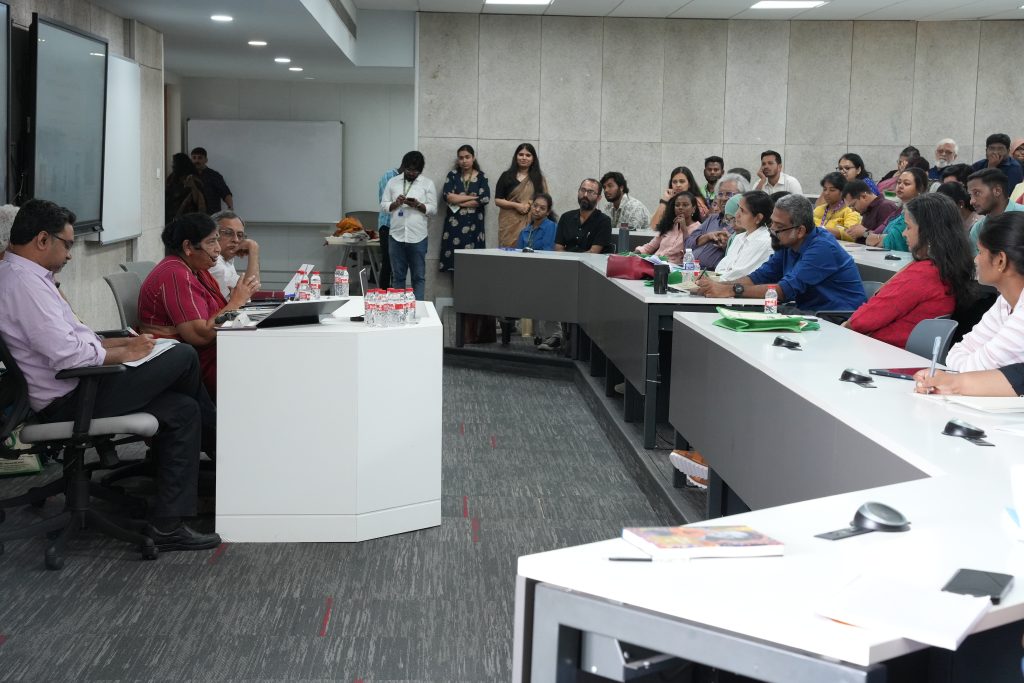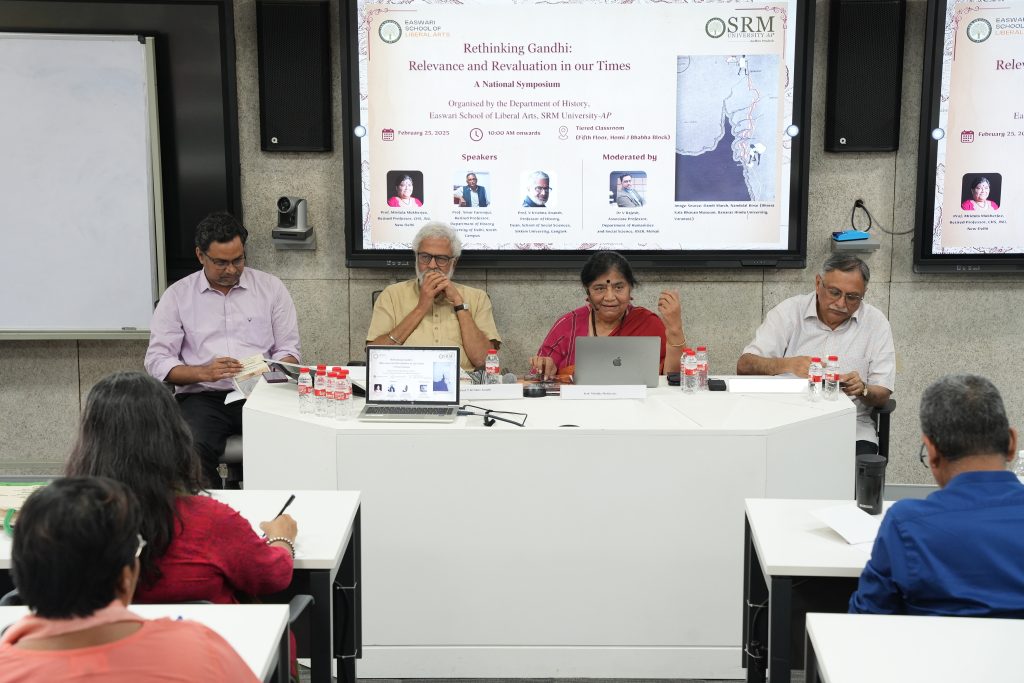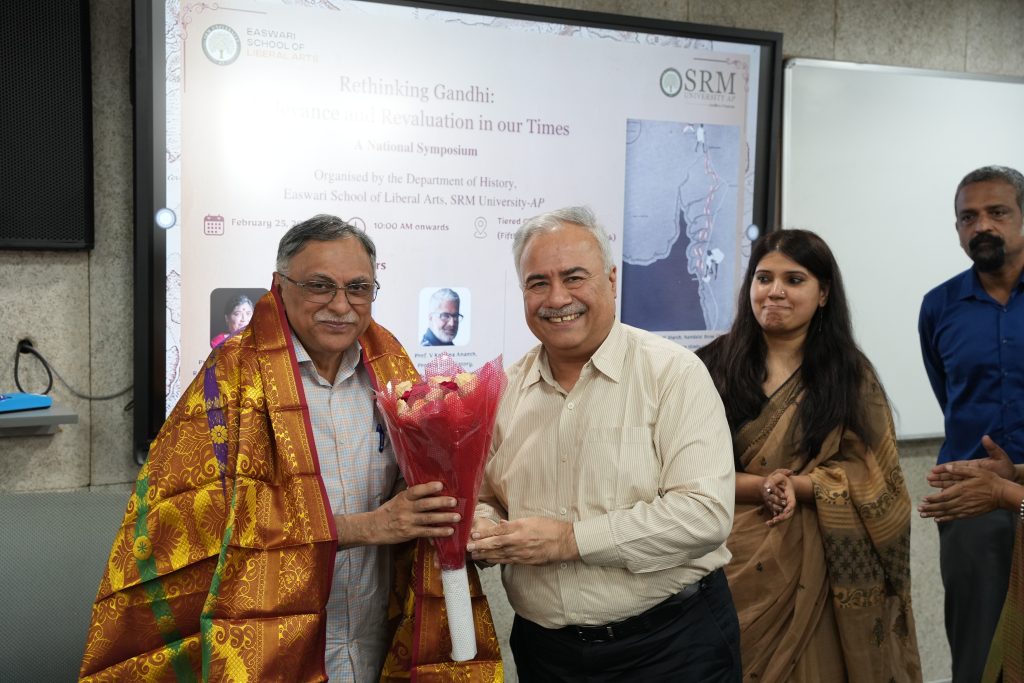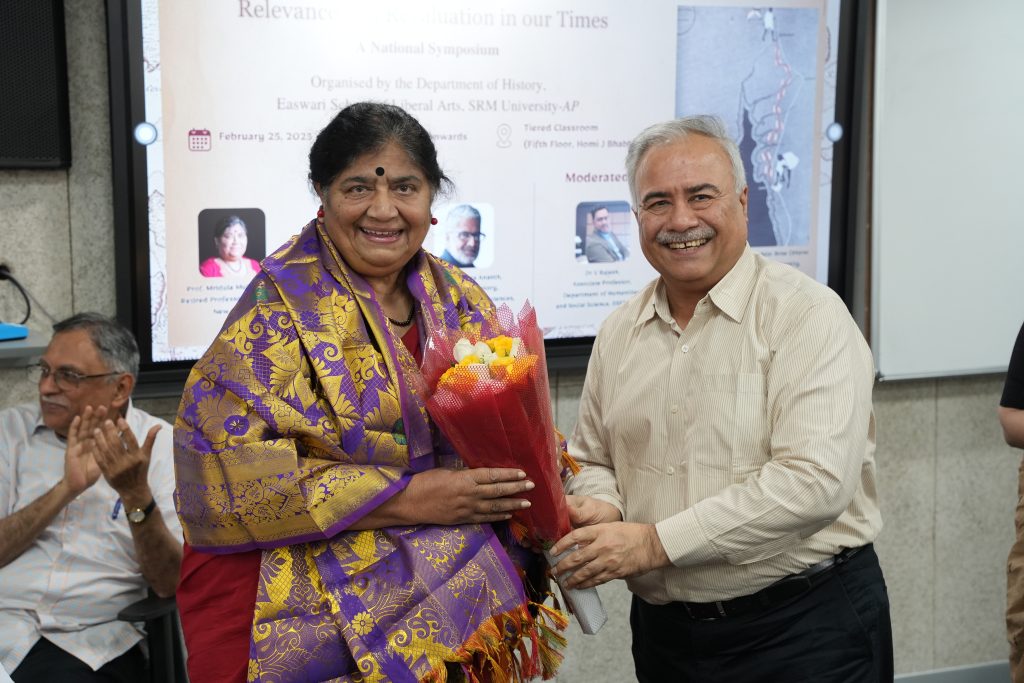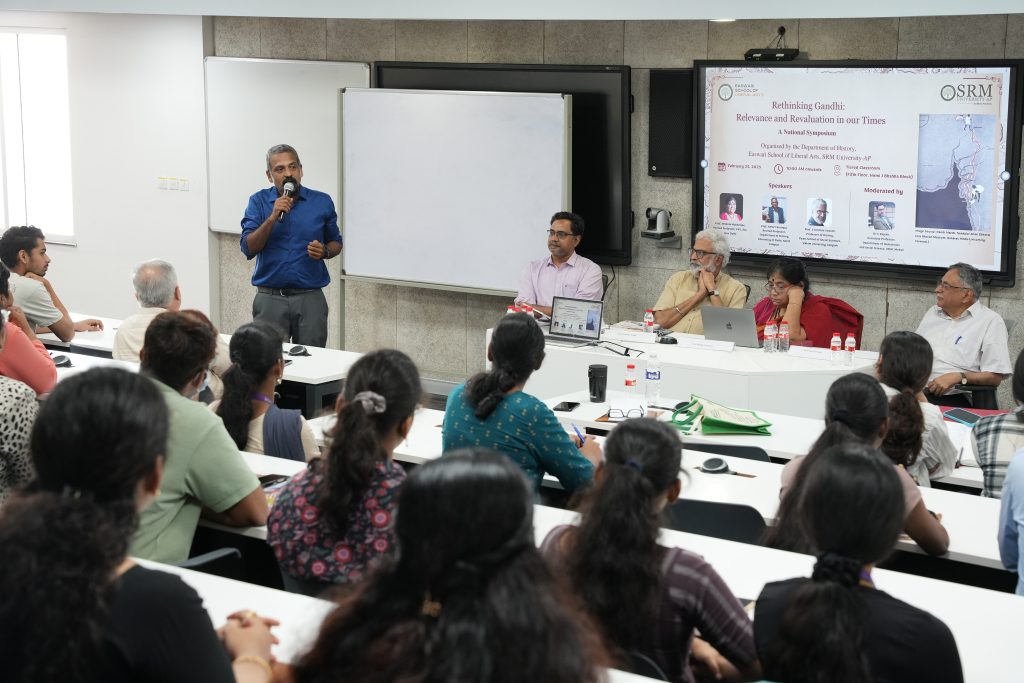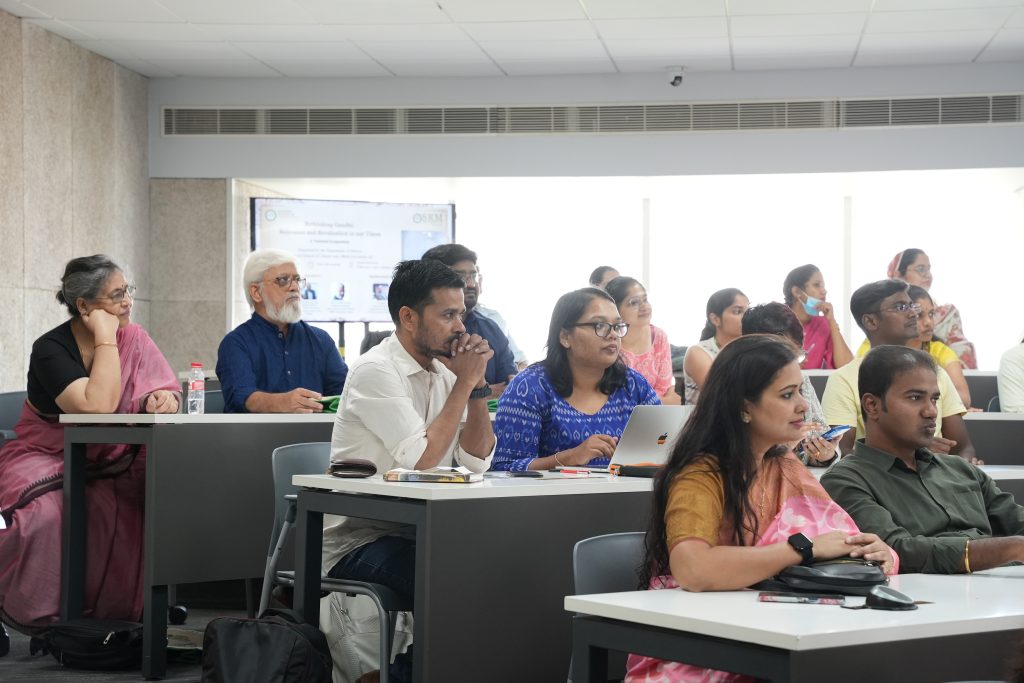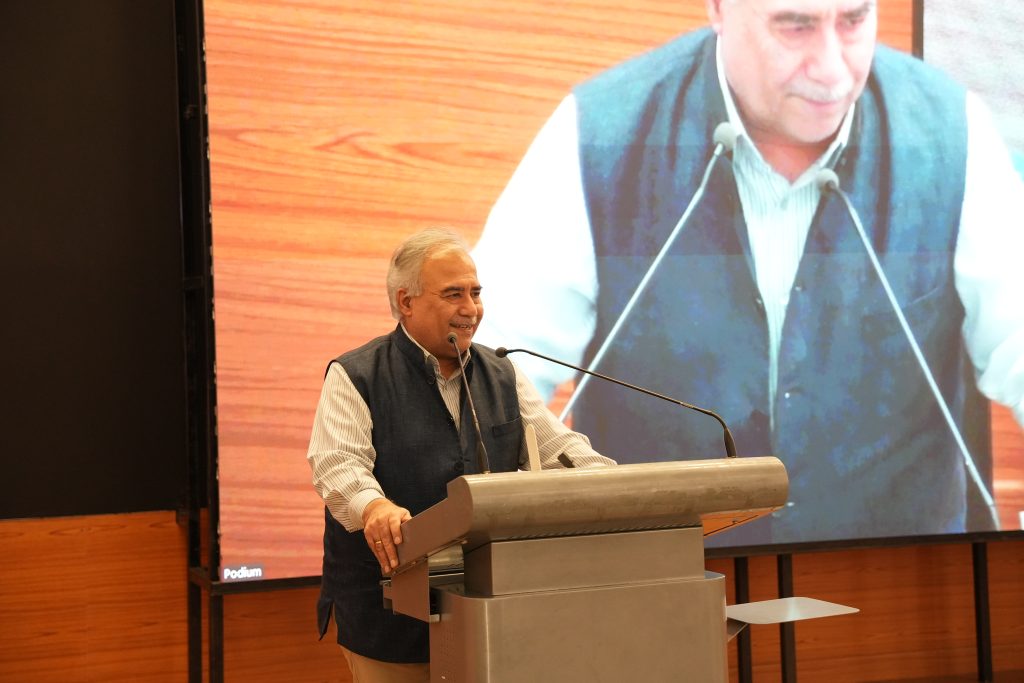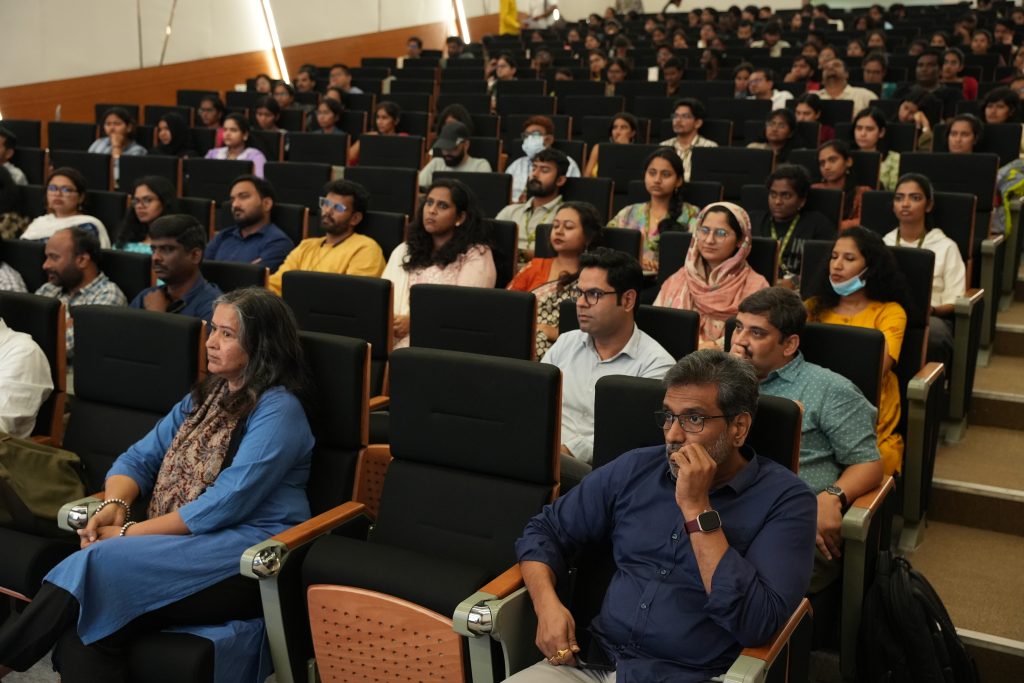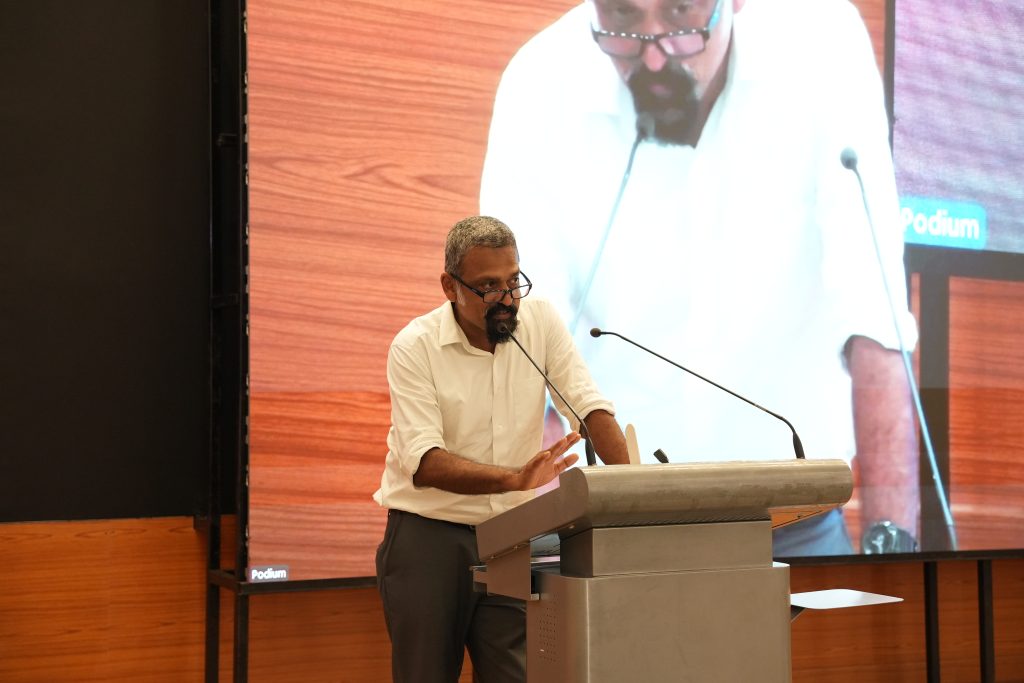Research News
- Patent on Pneumonia Diagnosis Using Deep Learning Techniques February 27, 2025
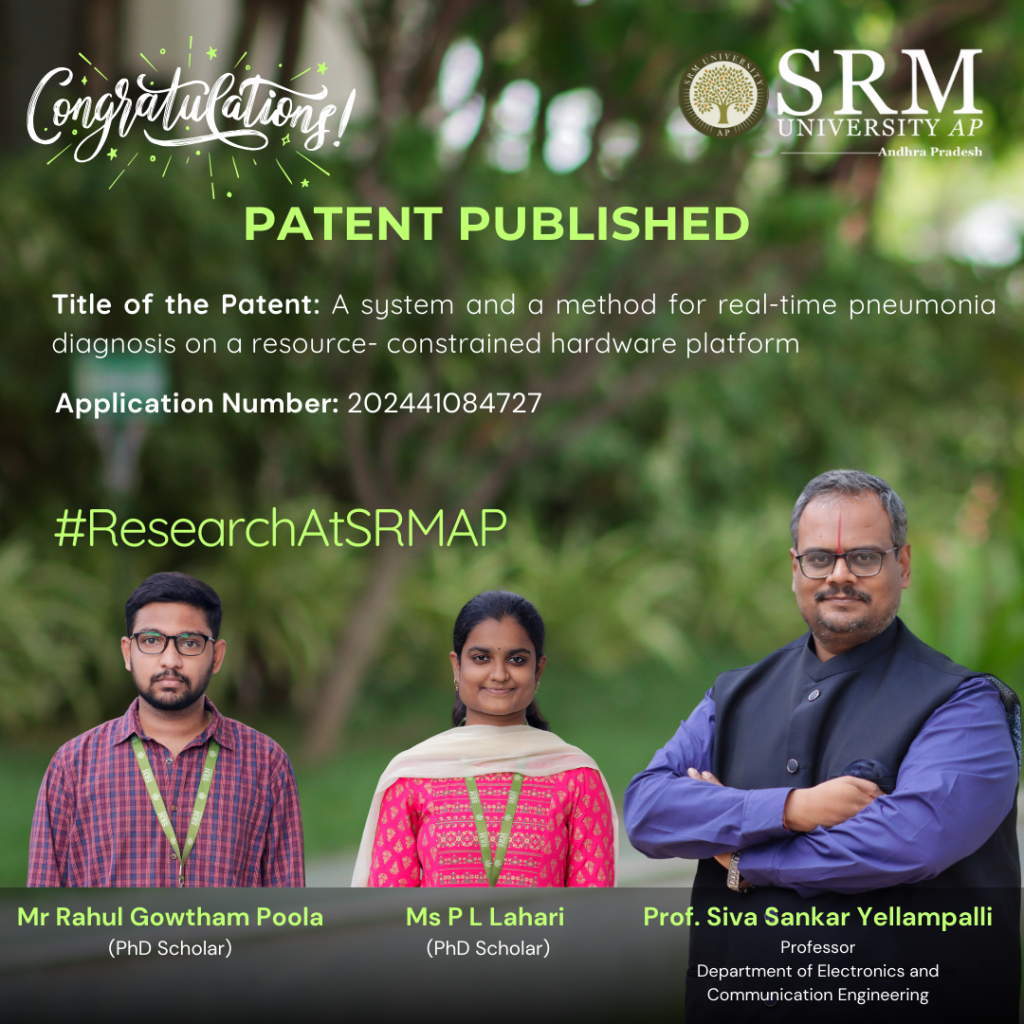 In the patent titled “A System and a Method For Real-Time Pneumonia Diagnosis On a Resource- Constrained Hardware Platform,” authored by Prof. Siva Sankar Yellampalli from the Department of ECE and his research scholars – Mr Rahul Gowtham Poola and P L Lahari, a novel diagnostic solution is presented to enhance pneumonia detection in low-resource settings. With Application No: 202441084727, this research explores the integration of advanced deep learning techniques with a compact microcontroller-based system, providing an innovative approach to improve healthcare accessibility and prompt medical intervention.
In the patent titled “A System and a Method For Real-Time Pneumonia Diagnosis On a Resource- Constrained Hardware Platform,” authored by Prof. Siva Sankar Yellampalli from the Department of ECE and his research scholars – Mr Rahul Gowtham Poola and P L Lahari, a novel diagnostic solution is presented to enhance pneumonia detection in low-resource settings. With Application No: 202441084727, this research explores the integration of advanced deep learning techniques with a compact microcontroller-based system, providing an innovative approach to improve healthcare accessibility and prompt medical intervention.Abstract:
The research focuses on the development of an innovative system for real-time pneumonia diagnosis leveraging advanced deep learning techniques integrated with edge computing technology. The proposed solution employs the MAX78000 microcontroller, a resource-constrained hardware platform, to deploy a sophisticated neural network model capable of analyzing chest X-ray images. The invention addresses the pressing need for accessible, cost-effective, and efficient diagnostic tools in under-resourced and remote environments. The system encompasses a complete diagnostic pipeline, including image acquisition via an onboard parallel camera module, real-time image processing, and display of results on a 3.5″ touch-enabled TFT screen. The deep learning model, optimized for the constraints of the MAX78000, performs real-time classification of chest X-ray images into either normal or pneumonia-affected categories. By operating entirely on-device, the system eliminates the need for high-power servers or internet connectivity, thereby reducing latency and dependency on external infrastructure. This research emphasizes portability, energy efficiency, and low-cost deployment, making the solution highly suitable for primary healthcare facilities, rural clinics, mobile health units, and disaster-response scenarios. With the ability to deliver immediate, accurate diagnoses, the device significantly enhances clinical decision-making and enables timely medical intervention. Additionally, the scalable and adaptable design of the system opens possibilities for broader medical imaging applications, extending its utility beyond pneumonia diagnostics. Experimental results showcase the performance of the neural network model, demonstrating prediction accuracies ranging between 66% and 97% for different test cases on the MAX78000 microcontroller. These findings underline the potential of the proposed system as a transformative tool for advancing point-of-care diagnostics in low-resource settings.
Explanation in Layperson’s terms.
The research presents a compact, affordable device that helps doctors quickly detect pneumonia by analyzing chest X-ray images in real-time. It uses advanced artificial intelligence (AI) technology, called deep learning, to examine the X-rays and determine whether a patient has pneumonia or not. What makes this device special is that it works entirely on a small, low-power microcontroller called the MAX78000, instead of needing powerful computers or internet access. The process begins when the device captures a chest X-ray image using its built-in camera. Then, the AI model, which has been trained to recognize patterns associated with pneumonia, analyzes the image. The results are displayed instantly on a small screen, allowing healthcare providers to make quick decisions. This real-time diagnosis can be life-saving, especially in emergency or rural settings where access to advanced medical equipment or high-speed internet is limited. Technically, this system combines AI and edge computing, meaning all the heavy processing happens directly on the device rather than in remote servers. This design keeps costs low, ensures patient data privacy, and makes the device highly portable and energy-efficient. The technology can work even in places with unreliable electricity, making it ideal for use in mobile health units, rural clinics, or disaster zones. Additionally, the invention can be adapted for diagnosing other diseases, showcasing its versatility in improving healthcare globally.
Practical Implementation
This research can be practically implemented as a compact, standalone device for diagnosing pneumonia in healthcare settings where access to advanced medical equipment is limited. It works as follows:
- Deployment in Rural Clinics and Mobile Health Units: The device can be used in clinics in remote or underserved areas where large X-ray machines and advanced computing resources are unavailable. It provides on-the-spot diagnosis.
- Point-of-Care Diagnostics: The portability and integration of image acquisition, AI-based processing, and display into a single unit make it ideal for bedside use in hospitals or during emergency care.
- Disaster Response: Its low-power and internet-free design make it a critical tool in disaster zones, refugee camps, or any setting where power and connectivity are unreliable.
- Telemedicine Integration: The device can complement telemedicine by providing accurate diagnostic results to remote doctors, helping bridge the gap between frontline healthcare workers and specialists.
Social Implications
Improved Access to Healthcare: By making pneumonia diagnosis accessible in rural and underserved regions, this device can drastically reduce the gap in healthcare services between urban and remote areas. It empowers healthcare providers in low-resource settings to deliver timely diagnoses.
- Affordability: The use of a low-cost microcontroller ensures that the device is affordable for governments and healthcare organizations, particularly in developing countries. This can enhance healthcare access for low-income populations.
- Reduced Mortality Rates: Pneumonia is a leading cause of death in children under five and elderly individuals, especially in low-income countries. This device’s ability to provide real-time, accurate diagnosis allows for earlier intervention and treatment, potentially saving countless lives.
- Privacy and Security: Since all data is processed locally on the device, it ensures patient privacy by eliminating the need to transfer sensitive medical data to cloud servers, addressing concerns about data security.
- Scalability: The underlying technology can be adapted to diagnose other diseases, creating a broader impact on global health. For example, similar systems could be used for tuberculosis, COVID-19, or other respiratory conditions, further enhancing healthcare infrastructure.
By addressing critical gaps in diagnostic capabilities and ensuring accessibility and affordability, this research has the potential to transform healthcare delivery and improve quality of life, especially in marginalized communities.
Collaborations:
Rahul Gowtham Poola, Ph.D Scholar, Dept of ECE, SRM University-AP
P.L. Lahari, Ph.D Scholar, Dept of ECE, SRM University-AP
Prof. Siva Sankar Yellampalli, Professor of Practice, Dept of ECE, SRM University-AP
- Dr Haque’s Patent Revolutionises the Digital Marketing Landscape February 27, 2025
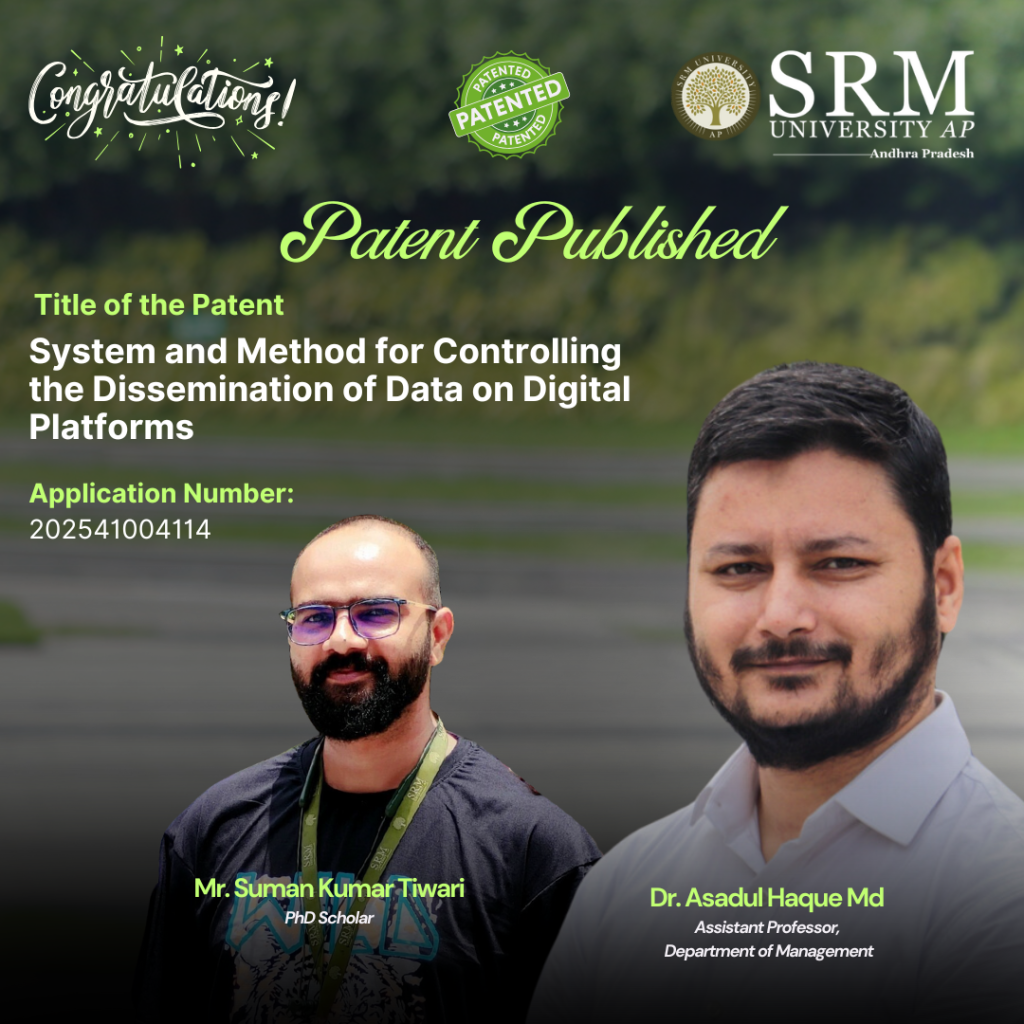 The patent titled “System and Method for Controlling the Dissemination of Data on Digital Platforms,” authored by Assistant Professor, Dr M Asadul Haque from the Department of Management and his research Scholar Mr Suman Kumar Tiwari offers an innovative approach to enhancing advertising strategies on digital platforms. With application number 202541004114, their patent outlines a comprehensive system that utilises real-time data collection and analysis to optimise consumer engagement and improve brand effectiveness in the ever-evolving landscape of social media advertising.
The patent titled “System and Method for Controlling the Dissemination of Data on Digital Platforms,” authored by Assistant Professor, Dr M Asadul Haque from the Department of Management and his research Scholar Mr Suman Kumar Tiwari offers an innovative approach to enhancing advertising strategies on digital platforms. With application number 202541004114, their patent outlines a comprehensive system that utilises real-time data collection and analysis to optimise consumer engagement and improve brand effectiveness in the ever-evolving landscape of social media advertising.Abstract
The patent outlines a novel system and method for optimizing the dissemination of data on digital platforms, specifically targeting the enhancement of advertising strategies through real time data collection and analysis. This system leverages APIs and web scraping for continuous, up-to-date consumer behaviour monitoring, enabling brands to make immediate adjustments to their advertising tactics based on current trends and insights. It employs advanced machine learning algorithms and sentiment analysis to detect intricate consumer response patterns, offering a nuanced understanding of advertisement effectiveness. Additionally, the system supports dynamic strategy optimization, facilitating real-time adjustments to advertising efforts in response to market and consumer behaviour shifts. It incorporates a holistic evaluation approach, considering various mediating and moderating factors such as consumer attitudes and platform types. Designed for scalability across multiple social media platforms, the system ensures compliance with data privacy regulations while performing real-time data collection and analysis. Ultimately, this patent presents a comprehensive feedback system aimed at improving consumer engagement and conversion rates through personalized and effective advertising strategies.
Explanation in Layperson’s terms
The research presents an innovative system aimed at improving advertising strategies on social media platforms. This smart system uses data analysis and machine learning to help brands understand the impact of their ads on consumer buying decisions. By collecting and analysing data from social media, it considers various factors such as ad content, social trends, and consumer sentiments. The system can predict the effectiveness of different advertising strategies before they are implemented, enabling brands to make informed decisions.
Traditional methods focus on basic metrics like ad clicks, but this invention provides a comprehensive view of what influences consumer behavior. It allows brands to adjust their advertising strategies in real-time based on consumer reactions, making campaigns more effective.
Benefits for businesses include better consumer engagement, higher sales, data-driven decision-making, and more efficient use of advertising budgets. The technology is particularly valuable for marketing agencies, online retailers, consumer product companies, and tech startups focused on marketing solutions.
Practical Implementation
The practical implementation of the new advertising system involves several key steps to ensure its effectiveness and ethical use. Firstly, the system integrates with existing social media platforms and advertising tools like Facebook Ads and Google Ads, enhancing advertising strategies. To ensure successful adoption, companies need to provide comprehensive training and support for their marketing teams, enabling them to use the new tools and interpret insights effectively. Before a full-scale rollout, businesses can conduct pilot programs to test the system on a smaller scale and make necessary adjustments based on real-world results. Ensuring adherence to data privacy regulations, such as GDPR, is crucial for the responsible and ethical handling of consumer data. Additionally, the system can be customized to meet the specific needs of various industries, by analysing sector-specific consumer behaviour and trends, which ensures tailored and effective advertising strategies.
Social Implications
The social implications of implementing the new advertising system are multifaceted. Firstly, it enhances consumer awareness by enabling brands to create more relevant and personalized advertisements, thus improving consumer experience and engagement. However, there is a potential risk of market saturation, where the overuse of similar strategies by multiple brands could overwhelm consumers with excessive ads. Privacy concerns are also significant, as increased data collection necessitates a careful balance between effective targeting and respecting consumer privacy. Additionally, automation and advanced analytics may shift job roles within marketing teams, prompting the need for reskilling towards more strategic, creative, and analytical tasks. The system promotes ethical marketing practices by leveraging data-driven insights to prevent misleading advertisements and ensure truthful marketing messages. Lastly, by understanding consumer sentiment, brands can influence societal trends and public perceptions, particularly through socially responsible marketing efforts.
Future Research Plans
• Exploration of Data Privacy Solutions- Investigate methods to enhance data privacy and security while still leveraging consumer data for effective advertising.
• Longitudinal Studies on Consumer Behaviour- Conduct longitudinal studies to understand how consumer behaviour changes over time in response to targeted advertising.
Continue reading → - National Symposium on Rethinking Gandhi in Contemporary Times February 27, 2025
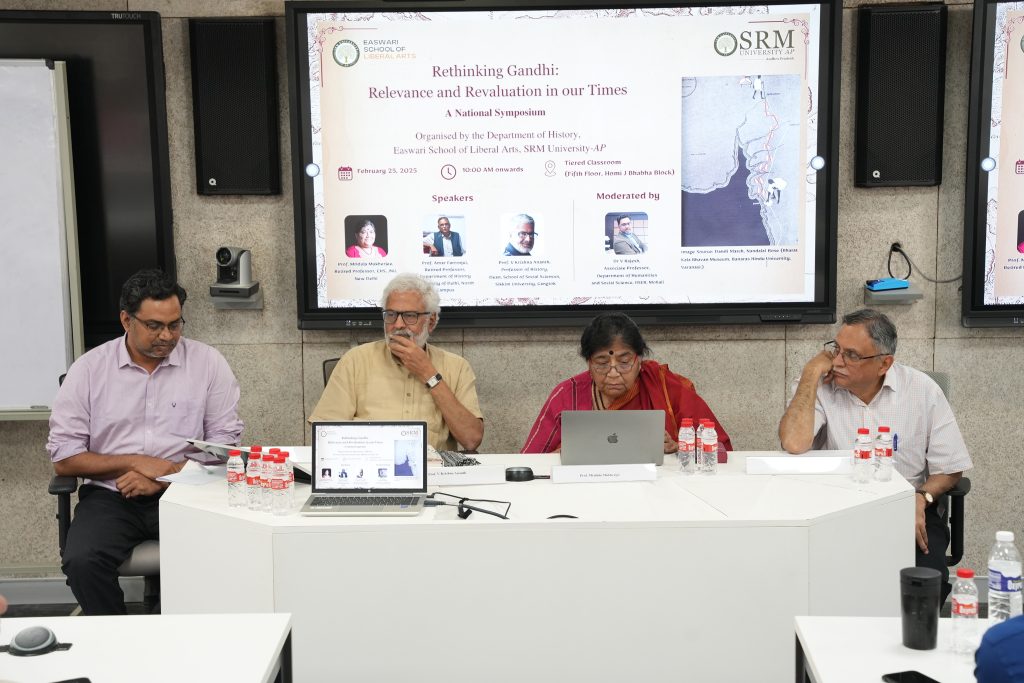
The Department of History from the Easwari School of Liberal Arts, hosted a national symposium on “Rethinking Gandhi: Relevance and Revaluation in our Times,” focusing on the facets of Gandhian legacy of meditation and tolerance. The symposium, held on February 25, 2025, witnessed an assembly of noted stalwarts of Gandhian Studies and modern South Asian history whose expertise in unpacking Gandhi and his politics is noteworthy. Prof. Mridula Mukherjee, Retired professor, JNU, Prof. Amar Farooqui, Retired professor, University of Delhi-North Campus, Prof. V Krishna Ananth, Professor of History, Dean of the School of Social Sciences, Sikkim University, Gangtok, delivered insightful sessions at the symposium moderated by Dr V Rajesh, Associate Professor, Department of Humanities and Social Science, IISER, Mohali.
Prof. Vishnupad, Dean of Easwari School of Liberal Arts, gave a comprehensive account of the relevance of revisiting the Gandhian legacy and ideology of inclusivity, compromise and tolerance in the contemporary world. He also opined the importance of liberal arts education in redefining oneself and shaping young minds into leaders and change-makers of tomorrow.
The symposium highlighted three perceptive lectures by leading academicians in Gandhian Studies. Prof. Mridula Mukherjee elucidated Gandhi as a leader of civil liberties. She commented, “Gandi’s doctrine placed democracy, civil liberties, and the notion of dissent in the forefront. His political ideology played with the terrains of legality and legitimacy.” Prof. Amar Farooqui discussed Gandhi’s relevance, particularly in relation to the idea of secularism. He commented, “Gandhi is uncompromisingly secular” and emphasised that Gandhi’s understanding of secularism remains relevant today.
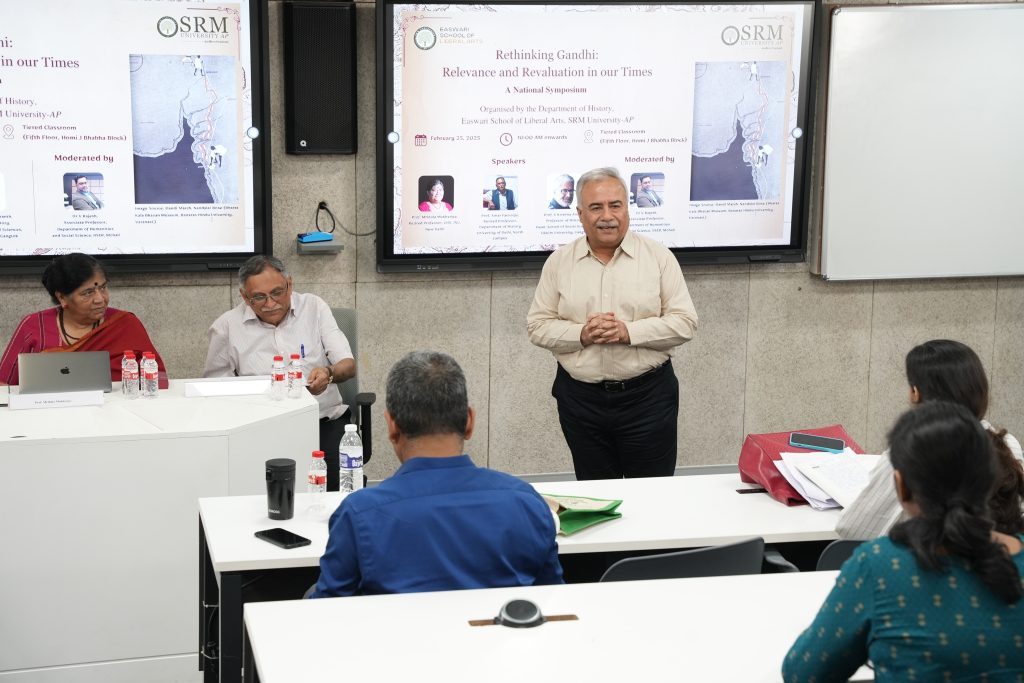
Prof. V Krishna Ananth highlighted that tolerance was central to Gandhi’s journey. He remarked that Gaandhi’s activism exposed the exploitative nexus between colonialism and financial power, a reality that remains relevant today. Dr V Rajesh moderated a Q&A session following the lectures.
Vice Chancellor Prof. Manoj K Arora expressed his appreciation to the Department of History and the Easwari School of Liberal Arts for this formidable initiative. He stated, “The National symposium is hugely beneficial for liberal arts students to enlighten the idea of swaraj. It is important for young minds to imbibe Gandhi’s teachings to strive towards a right and judicious world”.
The symposium aimed at revisiting Gandhi’s legacy, ideology, and vision and their relevance in the contemporary world. The event featured the participation of the Associate Dean of Easwari School of Liberal Arts, Prof. Vandana Swami, Head-Department of History Dr Aqsa Agha, Convenor of the symposium, Dr Maanvender Singh, faculty from the Liberal Arts school, research scholars, and students.
Continue reading → - Padmashri Prof. Shanti Sinha Discuss Child Labour and Child Rights in India at UDL#20 February 24, 2025
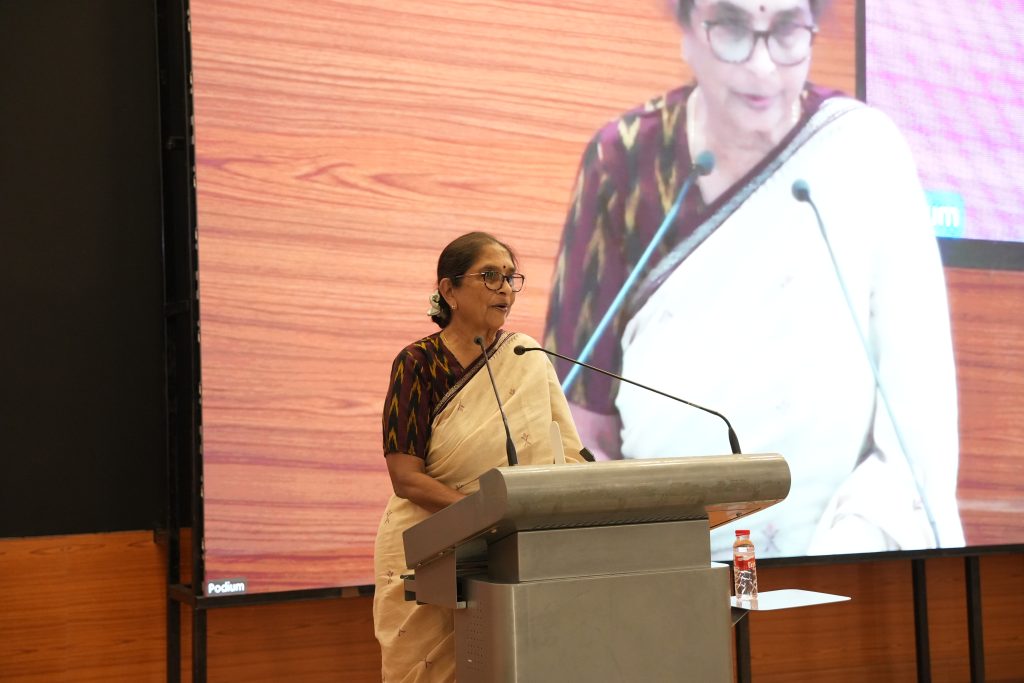
“Every Child Out of School is in Child Labour. Education, Education and Education alone is the Way Forward for a Progressing India.” – Prof. Shanti Sinha
The twentieth edition of the University Distinguished Lecture (UDL) on February 21, 2025, witnessed an invigorating session by the eminent anti-child labour activist Padma Shri Prof. Shanta Sinha, Ramon Magsaysay Awardee, Former Chairperson of the National Commission for Protection of Child Rights (NCPCR), and Professor (Retd.) Dept. of Political Science, Hyderabad Central University. The session on the topic “Making Education a Reality and Ending Child Labour: Experience of M.V. Foundation” gave an overview of the work of M.V. Foundation in the field of child rights in India.
In a society ravaged by poverty, where children were forced to join the bonded labour workforce, Prof. Sinha remarked that it was not poverty that led to child labour but child labour that led to poverty. Prof. Sinha elucidated on the non-negotiable principle adopted by the M.V. Foundation, that ‘no child must work, and every child must attend full-time formal day school,’ which broke the societal norms of Indian society.
She briefly spoke about the impact that the M.V. Foundation had and the ripple it created in the field of child rights. “M.V. Foundation has withdrawn over 15 lakh children in the age group of 5-14 years from child labour; stopped over 20,000 child marriages and pioneered a program for mainstreaming children to schools through residential bridge courses. The MVF’s mission to abolish child labour also led to the Closure of Night Schools and the creation of necessary amendments in the Child Labour Act of 1986,” stated Prof. Sinha.
The session also discussed Prof. Sinha’s Journey at the National Commission for Protection of Child Rights (NCPCR), and the various challenges faced in addressing key issues such as violation of children’s rights in relation to child labour and child trafficking, rights of children in areas of civil unrest, juvenile justice system, corporal punishment, child abuse and violence on children, and child malnutrition.
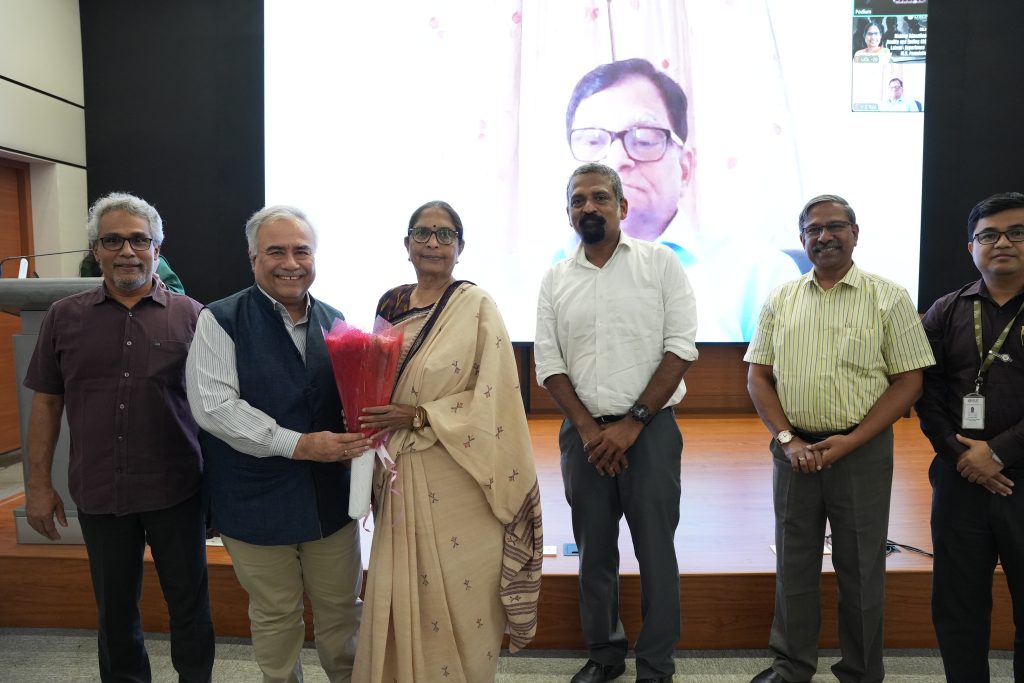
The UDL 20 was a mind opener and a lens into the reality of child labour still prevalent in India. Prof. Manoj K Arora, Vice Chancellor of SRM University-AP, expressed his gratitude to have the presence of a torchbearer of social reform at the UDL. He stated, “Prof. Sinha is a stalwart whose work has created a magnitudinal shift in the societal norm, significantly contributing to the abolition of child labour in India. We are grateful to imbibe from her knowledge and experience as a social leader.” Dean of Easwari School of Liberal Arts, Prof. Vishnupad, also expressed his heartfelt appreciation for Prof. Sinha’s presence and her work. He stated that the thought-provoking and inspiring session will ignite students to think in a ‘non-conventional’ way and offer courage to make a change.
The 20th UDL was organised under the aegis of the Office of Dean-Research, the UDL committee, and the Easwari School of Liberal Arts. It witnessed the presence of Registrar Dr R Premkumar, Dean of the School of Engineering and Sciences, Prof C V Tomy, Dean of Research, Prof. Ranjit Thapa, and Faculty and students of the varsity. The signature lecture series is the university’s flagship initiative to impart global exposure and quality education to its students.
Continue reading → - Patent on CBVR Published by Dr Jatindra Dash February 19, 2025
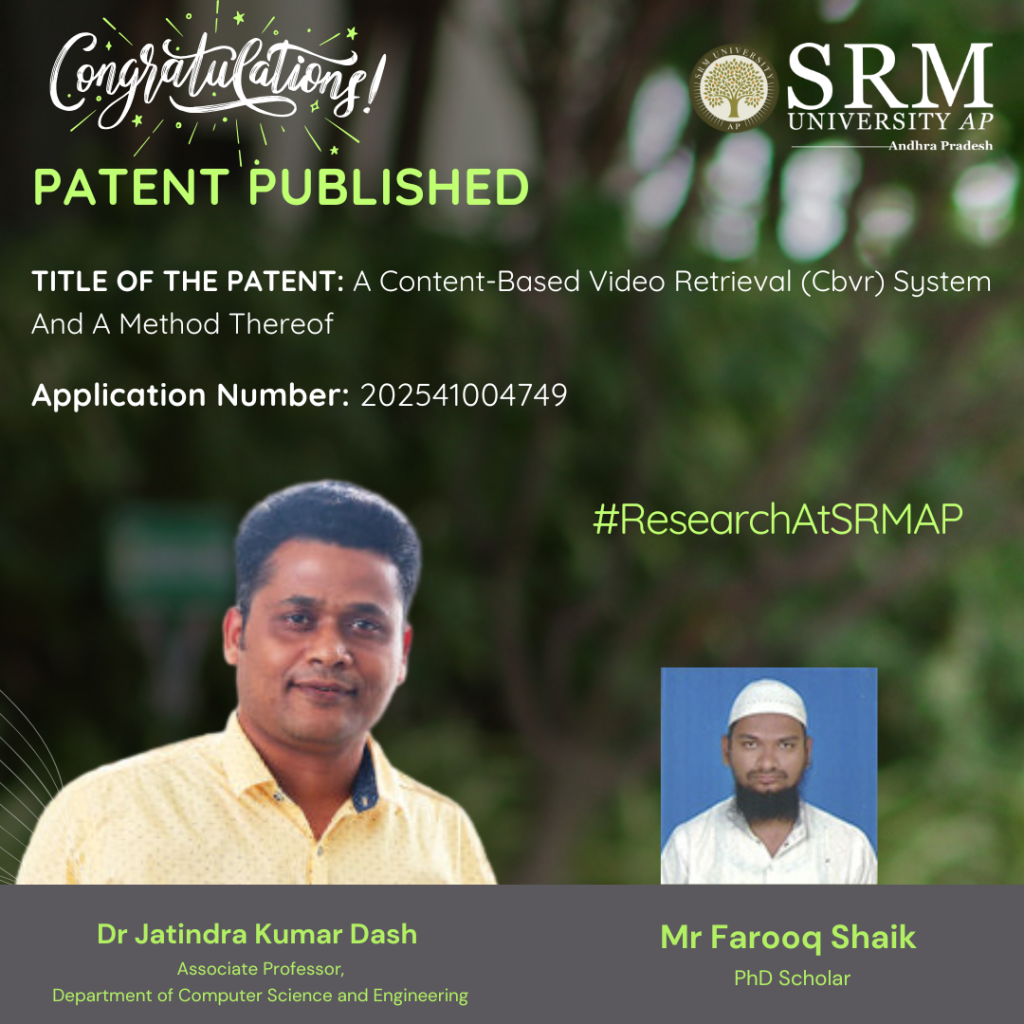 The Department of Computer Science and Engineering is delighted to announce the publication of a patent titled “A Content-Based Video Retrieval (CBVR) System and Method Thereof,” with application number 202541004749. The invention offers an efficient and accurate approach developed for content-based video retrieval by Dr Jatindra Kumar Dash, Associate Professor in the Department, along with his PhD scholar, Mr Farooq Shaik.
The Department of Computer Science and Engineering is delighted to announce the publication of a patent titled “A Content-Based Video Retrieval (CBVR) System and Method Thereof,” with application number 202541004749. The invention offers an efficient and accurate approach developed for content-based video retrieval by Dr Jatindra Kumar Dash, Associate Professor in the Department, along with his PhD scholar, Mr Farooq Shaik.Brief Abstract:
Imagine searching for a specific scene in a movie, not by remembering its title or actors, but by describing the action itself. This is the essence of content-based video retrieval (CBVR), a technique that searches for a video based on what’s inside it, rather than relying solely on manually assigned labels. Unlike traditional methods, which can be time-consuming, error-prone, and struggle with vast datasets, CBVR offers a more efficient and accurate approach. Our proposed system leverages the strong capability of deep learning, a subset of artificial intelligence, to analyse videos and extract their key characteristics. This process occurs in two stages: offline and online. Through the first stage, important features are extracted from all videos in the dataset and stored for future use. When a user submits a query video, its features are extracted in real-time (online) and compared to the stored features of all videos. The videos with features most similar to the query, essentially those with the “closest match” are then presented to the user. To capture the full essence of a video, our system employs a two-stream neural network architecture. This innovative approach allows us to extract both temporal features, which capture the changes and motion patterns within the video (think: someone running or jumping), and spatial features, which pivot about the static visual content of each individual frame (think: the objects and scene depicted).By utilizing a pre-trained neural network called ResNet-60, our system benefits from existing knowledge and can efficiently extract meaningful features from videos. To evaluate its effectiveness, we tested our system on the UCF101 dataset, a widely used benchmark consisting of 101 categorized videos. Our approach obtained accuracy 93,7\% for top 5 retrieval and 95.95\% for top 10 retrieval. The outcomes illustrate that our approach obtains superior accuracy compared to other state-of-the-art video retrieval methods.
Explanation in Layperson’s Terms:
Most of video searching platforms relay on meta data attached to video to search and retrieve videos. For example you tube utilize video name description attached to video while uploading. How ever this approach is time consuming, error prone, and need human intervention. Our proposed CBVR system aims to retrieve videos based on content of video similarity rather than meta tags. Proposed article utilized pre trained Deep neural network particularly ResNet-50 a convolutional neural network with residual skip connections to learn video representation by employing LBP representation and Temporal map of the video.
Practical Implementation and Social Implications
The research focus on CBVR a technique that enables users to search videos based on content rather than meta tags. It has many practical implementations in various industries, such as Surveillance and security (like to search large surveillance feed particular incident), Health care and medical imagining(where doctor retrieve similar medical video for faster diagnosis), Education , Entertainment.
The research has significant social implications such as Improved accessibility to information, enhanced public safety, Advancing ai in daily lifes. Using this system in smart cities and digital systems.
Collaborations
Experiments are conducted on publicly available Dataset on DGX-1 server available at our university premises. In future we may plan to collaborate with local authorities for real time video feed to enhance proposed method capabilities.
Future Research Plans
Further in to research our plan is to propose a robust system that can be scaled and applied to all scenarios of videos may it be Medical videos, Education. Further proposed method is supervised approach, we want to explore unsupervised methods to generalize video retrieval.
Continue reading →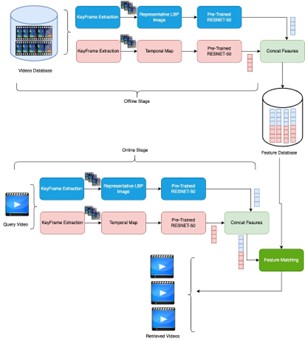
- Dr Debajyoti’s Research on Improving Biofuel Production February 19, 2025
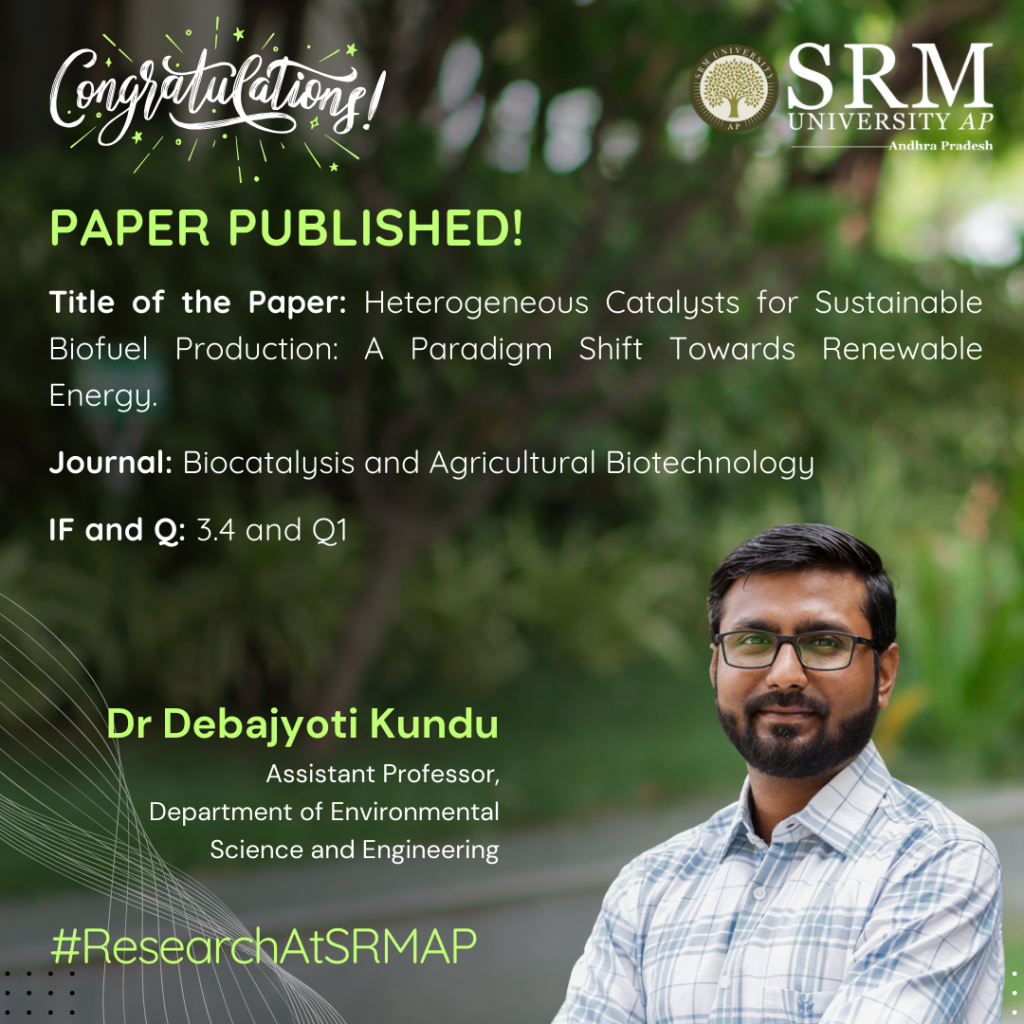 In the quest for sustainable energy solutions, Dr Debajyoti Kundu, from the Department of Environmental Science and Engineering, examines the potential of biofuels through his research paper – “Heterogeneous Catalysts for Sustainable Biofuel Production: A Paradigm Shift Towards Renewable Energy.” The paper highlights the importance of heterogeneous catalysts for improving biofuel production efficiency. The research also suggests future research to support sustainable energy practices.
In the quest for sustainable energy solutions, Dr Debajyoti Kundu, from the Department of Environmental Science and Engineering, examines the potential of biofuels through his research paper – “Heterogeneous Catalysts for Sustainable Biofuel Production: A Paradigm Shift Towards Renewable Energy.” The paper highlights the importance of heterogeneous catalysts for improving biofuel production efficiency. The research also suggests future research to support sustainable energy practices.Brief Abstract:
This study focuses on the use of heterogeneous catalysts for sustainable biofuel production. With the growing concerns around fossil fuel depletion and environmental pollution, biofuels derived from biomass are emerging as promising alternatives. The article explores the significant role of heterogeneous catalysts in enhancing biofuel production by improving conversion efficiency, recyclability, and environmental impact. By analyzing various biomass sources, structural compositions, and the application of catalysts in bioethanol, biobutanol, biodiesel, biogas, and biohydrogen production, the study highlights recent advancements and provides recommendations for future research to drive sustainable energy solutions.
Explanation in layperson’s terms:
This research looks at how we can produce more environmentally friendly fuels from natural materials like plants and waste. Traditional fuels like oil and coal are harmful to the environment, so we are turning to biofuels made from biomass (such as plants) as a cleaner alternative. A key part of making biofuels efficiently is using special catalysts—materials that help speed up chemical reactions. The study examines how different catalysts are used to convert biomass into biofuels such as bioethanol, biodiesel, and biogas. The goal is to improve the processes, making biofuels more sustainable and accessible for the future.
Practical Implementation and Social Implications:
This research has significant implications for advancing renewable energy. The use of heterogeneous catalysts can make biofuel production more efficient and environmentally friendly, reducing reliance on fossil fuels and mitigating climate change. By optimizing biofuel production processes, we can develop cleaner energy solutions that are sustainable, carbon-neutral, and beneficial for the environment. This study also supports the ongoing shift towards renewable energy, ensuring that biofuels can contribute to reducing global energy crises and health risks associated with fossil fuel use.
Future Research Plans
Our future research will focus on the development and optimization of biocatalysts for the bioconversion of biomass into biofuels. We aim to enhance the efficiency and sustainability of biocatalytic processes, exploring new catalysts and reaction conditions that can improve the conversion of various biomass feedstocks into valuable biofuels. This research will contribute to advancing biofuel production technologies, with an emphasis on reducing environmental impact and improving the scalability of bioconversion processes for renewable energy solutions
Continue reading → - Developing Organic Thin-Film Transistors into Biosensors February 17, 2025
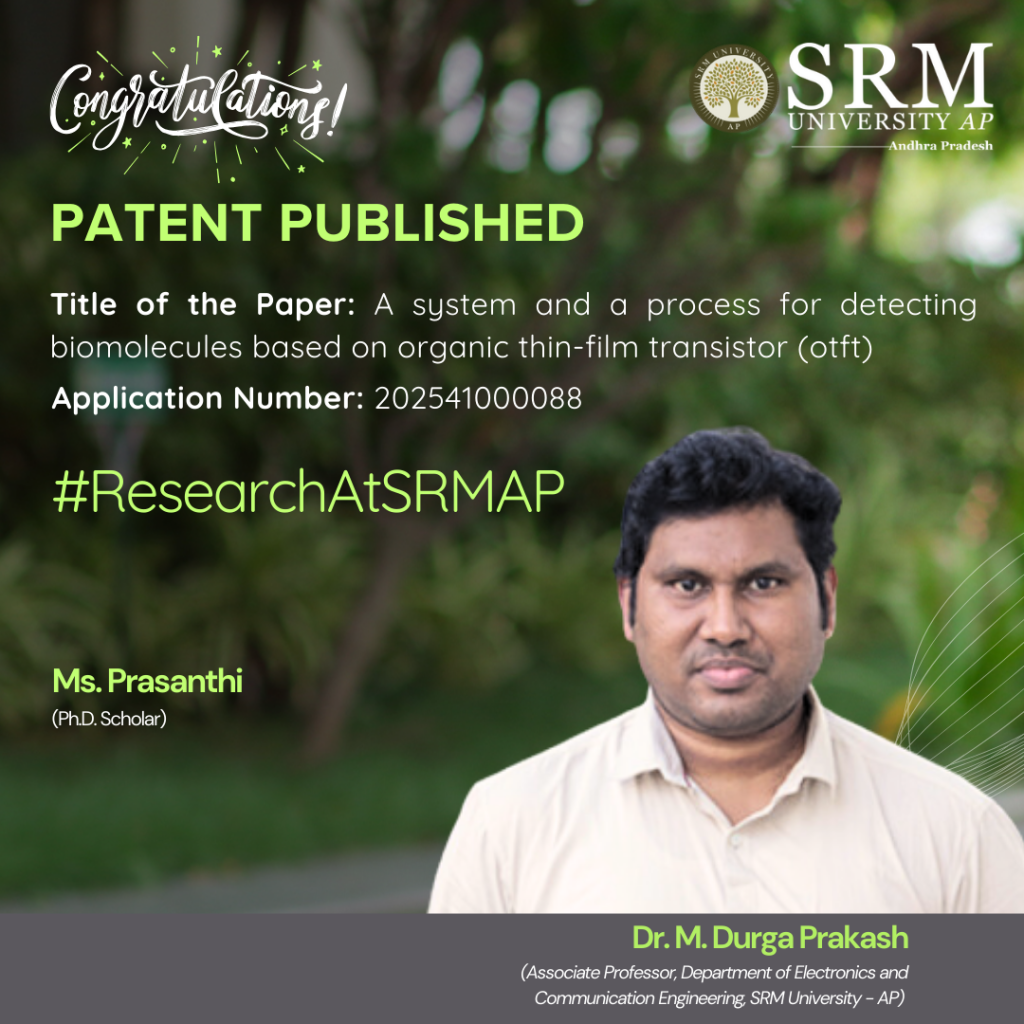
The Department of Electronics and Communication Engineering is proud to announce that Dr Durga Prakash M and his scholar Prasanthi Ms Prasanthi Lingala have their invention titled “An Organic Thin-Film Transistors (OTFTs) with Steep Subthreshold and Ultra-Low Temperature Solution Processing for Label-Free Biosensing” published in the Indian Patent Office Journal with the Application Number: 202541000088. Their research focus on developing an Organic Thin-Film Transistor (OTFT) that is able to work as a biosensor in detecting diseases or for real-time health monitoring.
Abstract
Organic Thin-Film Transistor (OTFT): The name “organic thin-film transistor” (OTFT) refers to a type of transistor that employs organic semiconductor materials in its active layer rather than the more traditional inorganic materials such as silicon. Optical thin-film transistors (OTFTs) are distinguished by their adaptability, low fabrication cost, and optimal applicability for electronic devices that are lightweight and portable. Considering their high sensitivity to changes in the surrounding environment and their compatibility with functionalised layers for the detection of biomolecules, these transistors find widespread application in the field of biosensors.
Explanation of the Research in Layperson’s Terms
Imagine a flexible electronic switch that can be bent, stretched, and used in lightweight devices—this is what an Organic Thin-Film Transistor (OTFT) does! Unlike traditional transistors made from rigid silicon, OTFTs use special organic materials, making them more adaptable for wearable sensors, flexible displays, and medical devices.
The research focuses on how these transistors can be used as biosensors, meaning they can detect tiny changes in the environment, like the presence of certain chemicals or biomolecules. This is important for medical testing, where OTFTs could help develop low-cost, highly sensitive diagnostic tools—imagine a simple patch that can detect diseases from sweat or a flexible sensor for real-time health monitoring! By improving how OTFTs interact with biological substances, the team aims to make them more accurate, efficient, and reliable for next-generation healthcare and wearable technology.
Continue reading →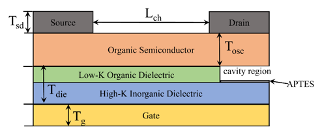
Fig.: Schematic structure of DNTT based OTFT
- Patent on Controlling DC-DC Buck Power Converters January 30, 2025
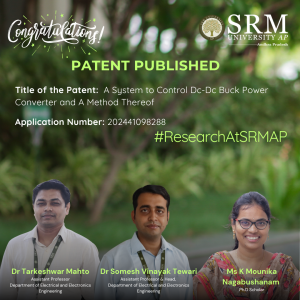 The patent titled “A System to Control Dc-Dc Buck Power Converter And A Method Thereof” by research scholar K Mounika Nagabushanam, and Assistant Professors, Dr Somesh Vinayak Tewari, and Dr Tarkeshwar Mahto with application no: 202441098288 presents an innovative approach to managing power conversion in renewable energy systems extending its applications in electric vehicles and microgrids, highlighting the importance of robust power control in advancing sustainable energy technologies.
The patent titled “A System to Control Dc-Dc Buck Power Converter And A Method Thereof” by research scholar K Mounika Nagabushanam, and Assistant Professors, Dr Somesh Vinayak Tewari, and Dr Tarkeshwar Mahto with application no: 202441098288 presents an innovative approach to managing power conversion in renewable energy systems extending its applications in electric vehicles and microgrids, highlighting the importance of robust power control in advancing sustainable energy technologies.Abstract
The work disclosed a system to control DC-DC buck power converter and a method thereof. The system comprises a photovoltaic (PV) panel, a first DC-DC buck converter for voltage step-down, and a battery for energy storage. A bidirectional DC-DC converter manages power flow between the battery and the source bus, while a second bidirectional converter exchanges power with the AC grid. The load bus integrates a second DC-DC buck converter to regulate power for constant power loads and resistive loads. Switching components like IGBTs controlled through PWM signals, ensure precise power control. Inductive and capacitive elements stabilize voltage, filter ripples, and reduce noise. The system supports adaptive power distribution and robust load handling, ensuring efficient energy management.
Explanation in layperson’s terms
Passivity-based control (PBC) is a control technique applied to buck converters within renewable energy systems to maintain stability and efficiency despite varying input conditions. Buck converters are essential for stepping down fluctuating voltage outputs from renewable sources, such as solar panels, to a consistent level suitable for storage or direct use. In solar power systems, PBC is used to manage the voltage conversion from solar panels to batteries or the grid. It stabilizes the voltage output, ensuring efficient battery charging and smooth integration with the electrical grid. PBC’s application in renewable energy systems demonstrates its critical role in advancing sustainable energy technologies, providing a reliable and efficient power supply.
Practical and Social Implications
The proposed control can be used in Electric Vehicle, Microgrid applications to stabilize voltage under load variations.
Future research plans
Future research plan is to work on the testing of proposed control with high level DC-DC converters
Continue reading →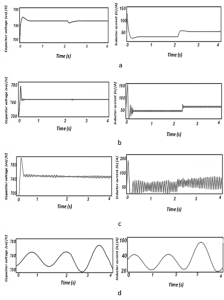
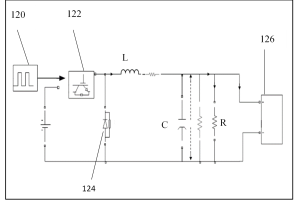
- Book Chapter on Wastewater Treatment and Energy Production January 29, 2025
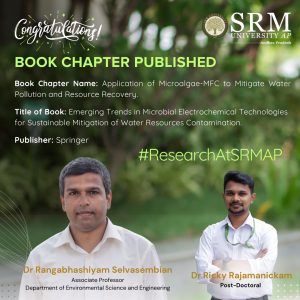 In an era where sustainable energy and environmental conservation are paramount, integration of Microalgae with Microbial Fuel Cells for Wastewater Treatment and Energy Generation emerges as a groundbreaking contribution to biotechnology. The book chapter, “Application of Microalgae-MFC to Mitigate Water Pollution and Resource Recovery” authored by Post-doctoral Research Scholar, Dr Ricky Rajamanickam under the guidance of Associate Professor and Head of the Department of Environmental Science and Engineering, Dr Rangabhashiyam Selvasembian explores the revolutionary potential of microalgae-driven microbial fuel cells (MFCs) in tackling wastewater pollution while generating renewable energy. This work—featured in the book titled, Emerging Trends in Microbial Electrochemical Technologies for Sustainable Mitigation of Water Resources Contamination brings together leading experts offering invaluable insights for scientists, engineers, and policymakers striving for a cleaner and greener future.
In an era where sustainable energy and environmental conservation are paramount, integration of Microalgae with Microbial Fuel Cells for Wastewater Treatment and Energy Generation emerges as a groundbreaking contribution to biotechnology. The book chapter, “Application of Microalgae-MFC to Mitigate Water Pollution and Resource Recovery” authored by Post-doctoral Research Scholar, Dr Ricky Rajamanickam under the guidance of Associate Professor and Head of the Department of Environmental Science and Engineering, Dr Rangabhashiyam Selvasembian explores the revolutionary potential of microalgae-driven microbial fuel cells (MFCs) in tackling wastewater pollution while generating renewable energy. This work—featured in the book titled, Emerging Trends in Microbial Electrochemical Technologies for Sustainable Mitigation of Water Resources Contamination brings together leading experts offering invaluable insights for scientists, engineers, and policymakers striving for a cleaner and greener future.Brief Introduction to the Book Chapter
The chapter explores the integration of microalgae with microbial fuel cells (MFCs) for simultaneous wastewater treatment and energy generation. It delves into the mechanisms of microalgae-based MFCs, focusing on electricity generation, carbon capture, and the production of value-added bioproducts. The work highlights this technology’s potential for addressing water pollution and resource depletion while advancing sustainable energy solutions.
Significance of the Book Chapter
This chapter is significant as it addresses pressing global challenges such as water pollution, resource depletion, and the need for sustainable energy solutions. It aligns with the Sustainable Development Goals and contributes to advancing integrated biotechnological solutions for environmental and energy challenges.
Target Audience
The book chapter targets environmental scientists, engineers, policy makers, and researchers working in biotechnology, wastewater management, and renewable energy. It is also resourceful for students and professionals interested in sustainable development and innovative biotechnologies.
Co-Authors or Major Contributors
Dr Ricky – (First author) (Postdoc)
Dr Rangabhashiyam Selvasembian (Corresponding author) (Associate Professor)
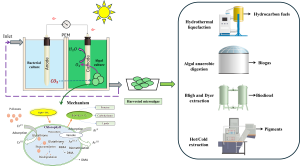
Continue reading → - Synthesising Flexible Solid-state Electrolytes for Electronic Devices January 29, 2025
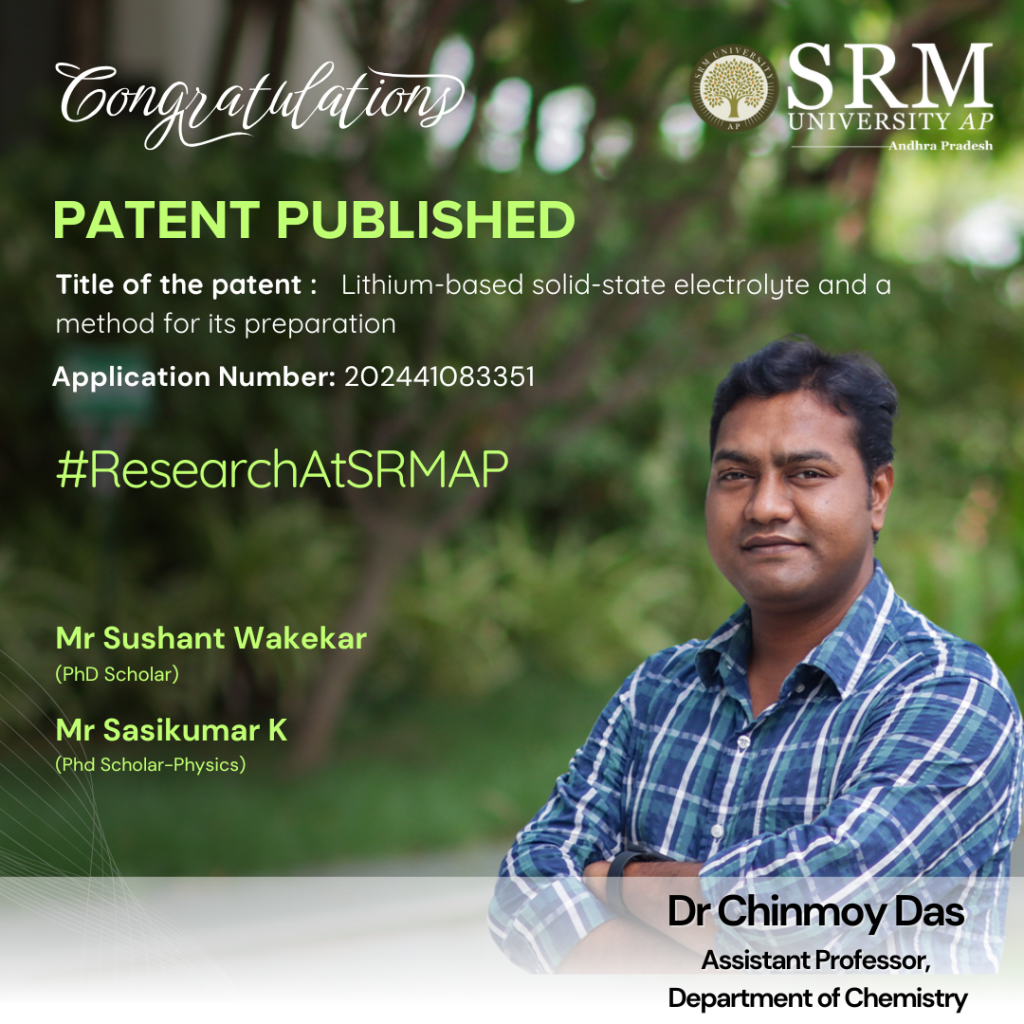
Dr Chinmoy Das, Assistant Professor from the Department of Chemistry, and scholars Mr Sushant Wakekar and Mr Sasikumar K have published their invention titled “Li-based solid-state electrolyte and a method for its preparation” in the Indian Patent Office (Patent application No. 202441083351). The invention illustrates how to synthesise inexpensive Li(I) ion-based solid-state electrolytes that are feasible for fabricating flexible electronic devices. The team worked on inexpensive and readily available starting materials that provide self-supported and flexible solid-state electrolytes to advance LIB applications.
Abstract
In our invention, we described a rapid and robust synthetic methodology to prepare novel flexible solid-state electrolytes (SSEs) suitable for the fabrication of eco-friendly lithium-ion batteries (LIBs). The mechanically flexible film has been synthesized upon in situ incorporation of Li(I) ion into two inexpensive biocompatible polysaccharide matrices through mixing. We achieved Li(I) ion-based superionic conductivity at room temperature which is feasible for the fabrication of flexible electronics in modern age society.
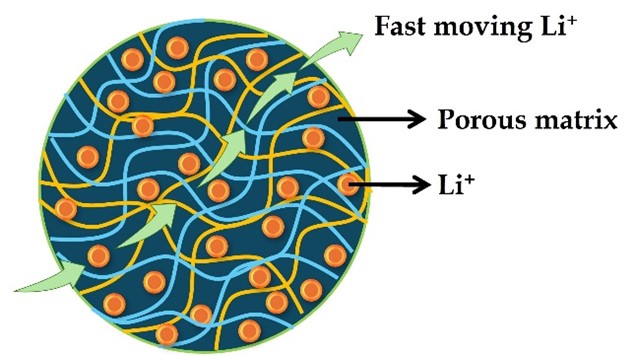
Practical Implementation/Social Implications of the Research
This invention can be implemented in various industries, such as electric vehicles (EVs), wearable and flexible electronics, and aerospace and aviation.
The team is extending their research towards the fabrication of cheaper sodium (Na+), potassium (K+)-ion based solid-state electrolytes with superionic conductivity and implementing them in designing the biodegradable sodium-ion / potassium ion batteries (NIBs / KIBs).
Continue reading →


